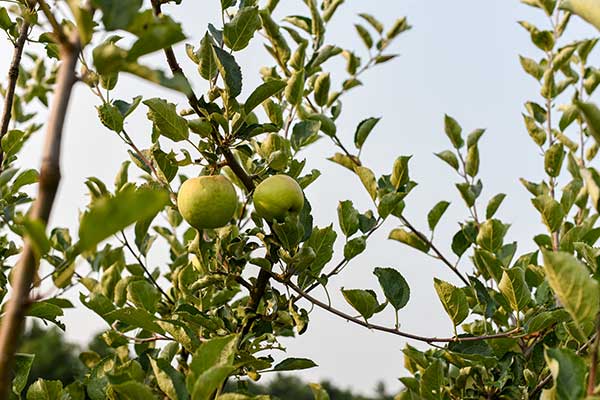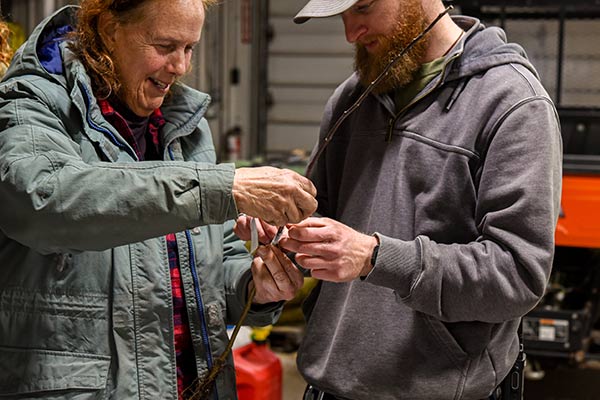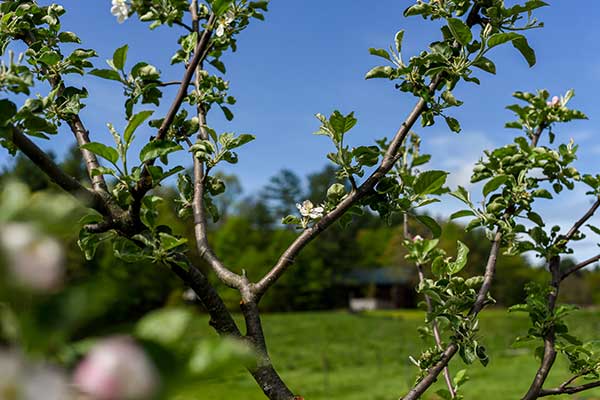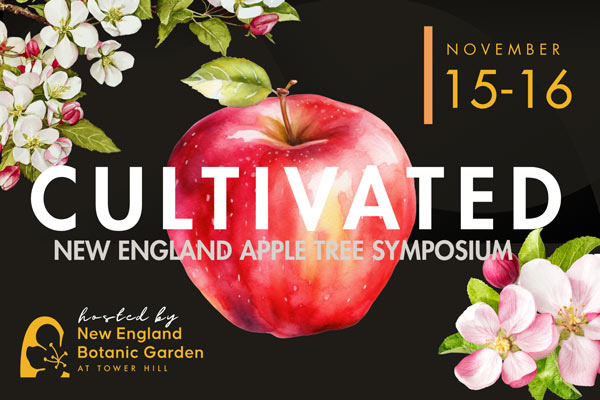By Liz Nye, New England Botanic Garden
October 2025
What’s in an heirloom apple name? Would a ‘Late Strawberry’ by any other name taste as sweet? Probably!
Heirloom apples, varieties chosen for unique attributes from taste and color to texture, size, and functionality, racked up common names as they were passed down over generations from one grower to the next. Take the ‘Lyscom’ whose synonyms include ‘Martha Stripe,’ ‘Mathis Stripe,’ ‘Matthew’s Stripe,’ ‘Nonpareil,’ ‘Osgood’s Favorite,’ and more. The slew of nicknames that can be accumulated by an old apple variety are a part of its charm—and a challenge when it comes to preserving them.

Two apples fruit on ‘Late Strawberry,’ one of the 119 heirloom varieties in the Garden’s collection.
Enter one of New England Botanic Garden’s dedicated horticultural volunteers, Leslie Duthie, who recently added “heirloom apple sleuth” to her long list of botanical accomplishments. Duthie, who began volunteering at the Garden in 2018, plays an essential role in the preservation of the Frank L. Harrington Orchard, an effort that involved the complete replacement of every single tree a few years ago when the orchard was threatened by fire blight. Duthie is now on a mission to ensure the historic orchard is not only given the consistent care it needs to thrive but also that every apple variety in the collection, 119 to be exact, is true to its name—or names, in some cases. And it is a mission that is proving full of surprises.
The Garden’s apple collection dates to the early 1900s and the Great Depression when Worcester County Horticultural Society trustee Stearns Lothrop Davenport began preserving old and uncommon apple cultivars, some with extremely local provenance. Building the collection almost a century ago relied on the record-keeping tools of the day. Highly skilled orchardists had only their senses to distinguish apple varieties with very similar traits. With advances in DNA technology, the Garden is now able to learn more about the origins of unusual apples in its collection and, in many cases, use genetic analysis to confirm records. Much like a museum curator verifying the painter of a piece of art, the value in preserving apple varieties can only be fully realized if their true identities are known.

In March 2024, Garden staff, alongside Leslie Duthie, grafted several varieties that had been missing or hadn’t made it through the winter.
Recent DNA testing of the Garden’s apples, conducted by Washington State University and in collaboration with partners at RegisTREE of North America, reveals that some are exceptionally rare—the only examples currently found in the DNA database. Results also show that a small number aren’t actually the varieties they were believed to be. Duthie was surprised to discover that the ‘Lyscom,’ for example, has been misrepresented in the Garden’s collection for years.
Apple varieties can only be preserved in living collections. They don’t “come true,” as horticulturists say, when grown from seed. The process of pollination introduces genetic material from other apple varieties, meaning that a seed from an ‘Opalescent’ apple will not grow a tree that produces apples that looks and tastes exactly like the original ‘Opalescent.’ To maintain the traits of a specific apple variety, trees must be asexually or clonally propagated through a process known as grafting. Through grafting, scionwood, shoot cuttings taken from new growth on existing trees, is carefully spliced into the rootstock of another tree.
The only way to complete the Garden’s collection and incorporate any missing varieties is to find living specimens and collect scionwood. Duthie hopes that the missing varieties can be traced to their roots—she has already discovered as much with the ‘Lyscom.’ A large, yellow-striped apple, the ‘Lyscom’ was first recorded in 1817 and named after the Southborough, Massachusetts farmer who grew it, Samuel Lyscom. In an old newspaper clipping, Duthie learned that the town of Southborough maintains a ‘Lyscom’ variety tree to honor their agricultural heritage.

Many varieties in the collection bloomed this spring, the first time the majority of the trees have flowered since their planting.
Preserving a complete and correct apple collection has implications beyond the Garden’s orchard. While verifying identities and finding missing varieties, Duthie forges connections between the Garden, researchers, nurseries, and orchards. This work elevates identification standards that strengthen broader heirloom apple conservation efforts. As her detective work continues, more stories about the people and places that shaped the Garden’s unique collection are bound to arise, so stay tuned!
For those looking for additional opportunities to dive deeper into the world of heirloom apples and learn more about the Garden’s special collection, a full-day symposium all about apples is coming up on November 15.
 Cultivated: New England Apple Tree Symposium
Cultivated: New England Apple Tree Symposium
Saturday, November 15, 9 a.m.-4 p.m. | On-Site at New England Botanic Garden
Sunday, November 16, 10 a.m.-4 p.m. | Off-Site Massachusetts Cider House Experience
Liz Nye is the Public Relations Manager at New England Botanic Garden. She holds a master’s degree in science writing from Johns Hopkins University and enjoys learning about and writing about all things plants.
